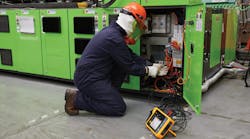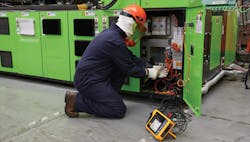6 power quality measurements to uncover hidden issues in electrical systems
Hundreds of power quality measurements monitor electrical systems on your motors and drives. But these six, specific measurements can help uncover hidden issues in a plant’s energy use which often lead to additional costs, equipment damage, and even unscheduled downtime.
1. Voltage unbalance
In a balanced, three-phase system, the phase voltages should be equal or very close. An unbalance in these measurements can cause poor performance or premature failure. These large problems can be caused by smaller issues that are much easier to fix if caught during regular, preventive maintenance measurements, such as:
- mechanical stresses in motors, often due to lower torque
- high current in motors and three-phase rectifiers
- unbalance current flowing through neutral conductors in three-phase wye systems.
The major costs are associated with motor replacement and lost income due to circuit protection trips. Replacing equipment combined with the cost of labor for the work and the unplanned downtime can add up quickly.
To catch voltage unbalance issues, look at the inputs to motors, VFDs, and UPSs. It’s important to know how much of an unbalance should raise a red flag. According to the EN50160 power quality standard for required voltage unbalance, as a ratio of negative to positive sequence components, it should be less than 2% at the point of common coupling. NEMA specs call for less than 1% for motor loads. Consult your user manuals for other equipment. NEMA MG 1 states the motor must be derated for unbalance greater than 1%.
2. Total harmonic distortion
Total Harmonic Distortion (THD) is all harmonics on an asset combined. Some current distortion is normal, it’s a part of a power system supplying electronic loads such as computers, business machines, electronic lighting ballasts, and control systems. But anything more than 5% on any phase should be investigated further. At this level, or for longer periods of time, it can cause problems like:
- high current to flow in neutral conductors
- motors/transformers running hot, shortening their lives
- increased susceptibility to voltage sags, potentially causing resets
- reduced efficiency of transformers, or a larger transformer is required to accommodate harmonics
- audible noise.
The major costs of THD are associated with the life of motors and transformers shortening. If the equipment is part of production systems, income can be affected as well.
To find these kinds of issues, take measurements and track baseline normal for your motors, transformers, and neutral conductors serving electronic loads. Monitor current levels and temperature at transformers to be sure that they are not overstressed. Neutral current should not exceed the capacity of the neutral conductor.
3. Increasing phase current
As insulation deteriorates, it begins to leak. Loads will draw slightly higher current as they age, and they may send some of this leakage current into the grounding system. Faults within the equipment may also cause high ground current. These issues can lead to further damage, shortened asset life, unscheduled downtime, and unplanned cost if left for too long. Excessive phase currents can further damage insulation and overheat the load; over-current can cause protection devices to trip; and excessive ground current can create unsafe voltages on metal chassis, cabinets, and conduit.
With increasing phase current, the highest costs often come from premature motor failure and the lost income from over-current protection devices tripping. In order to catch these issues before they become too large, regularly check and monitor any critical load, but especially motors, VFDs, and transformers. The best way to check insulation is by periodically checking equipment with an insulation tester. You can also check equipment while it’s in service by measuring and tracking all the currents (phase, neutral, and ground) to make sure none of these are increasing significantly over time.
Measuring against the nameplate rating of the load should give you a baseline to raise red flags. The nameplate rating should never be exceeded. Track the phase current being drawn by a load over the months or years so you can get a sense whether the current is changing and take mitigating action before the issues are too big.
4. Voltage sags
Voltage sags are momentary reductions in RMS voltage. Loads may be added without notifying plant management, and these loads may draw down system voltage, especially if they draw high inrush currents. Also, as electrical systems age, the impedance of the system may increase, making the system more prone to voltage sags. Most loads will operate at 90% of nominal voltage, but if voltage sags further or for extended periods of time, it can cause resets on electronic equipment or overcurrent protection trips. Sags on one or two phases of three-phase loads can cause the other phase(s) to draw higher current to compensate.
Voltage sags can lead to lost income when a computer randomly resets, control system resets, VFD trips, and shortened life of backup power system’s UPS due to frequent cycling. As part of your preventive maintenance program, tracking measurements on motors, VFDs, UPSs, or panels serving power to computer equipment or industrial controls should help catch issues as they arise. Taking the steps to mitigate the problems before they get too large can save you unplanned downtime and cost.
5. Peak demand
Utilities monitor the amount of power a facility consumes. Several times an hour, utilities will calculate the average demand for that interval. Peak demand is the highest average demand during all the intervals in a billing cycle, and is what the company will charge based on. Commercial and industrial customers can manage the high cost of peak demand rates by staggering load cycles to reduce total draw at any one time.
The potential savings here depends on the rate schedule of the utility. But, checking a few things can help you adjust assets and schedules to cut peak demand rate costs, such as:
- Find out what demand interval the utility uses.
- Measure demand over time at the service entrance using a power quality logger.
- Look for significant loads operating concurrently, and use demand measurements to verify readings for the individual loads.
6. Power factor
Power factor is an equation to show energy efficiency in a facility. It’s the ratio of working power (measured in kW) to apparent power (measured in kVA). Apparent power, or demand, is how much power is used to run equipment and machinery. Apparent power is found through the total amount of working power (kW) and reactive power, or wasted power (kVAR), combined. Power factor is usually expressed as a percentage—and the lower the percentage, the less efficient power usage is.
Utilities may charge higher rates or penalties for low power factor, penalizing facilities requiring higher reactive power. To avoid paying higher utility fees, power factor should be higher than .97. System capacity restrictions cause voltage drops and overheating, so capacitors may be applied on individual loads, at a confluence of several loads, or at the service entrance to improve power factor.
Looking into a few areas can help you reduce these costs. Understand if your utility rate plan charges for reactive demand or low power factor. Find out how the utility measures power factor. Are they looking at peak intervals or averages?
Finally, while running preventive maintenance routes through a facility, identify loads that are causing lagging reactive power. Once you know where the issues may be coming from, you can develop a strategy for power factor correction and eliminate as many utilities penalties as possible.
This story originally appeared in the May 2022 issue of Plant Services. Subscribe to Plant Services here.
Jason Axelson is a product application specialist for Fluke, which manufactures electrical test and measurement tools, including multimeters, clamp meters and insulation, earth ground and installation testers. For more than 15 years Axelson has been helping customers and partners find solutions for Power Quality, Scope Meters and Battery Testers. He also conducts application training to help diagnose and resolve both technical and product inquiries.


